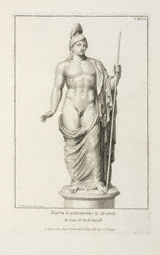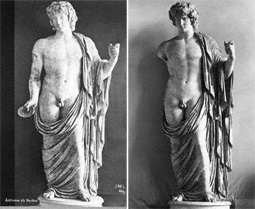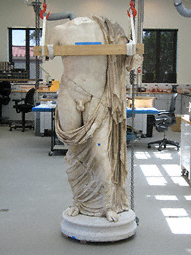 |

 |
 |
Statue of a God, Roman, A.D. 100–200
|
 |
 |
|
This exhibition traces the modern history of a monumental Roman statue of a god, on loan from the Skulpturensammlung, Staatliche Kunstsammlungen Dresden (Dresden State Art Collections), that has been restored in various guises over the last three centuries. Recently conserved at the Getty Villa, the sculpture today is identified as Bacchus, the Roman god of wine.
When found in Italy in the 1600s, the sculpture was missing its head, right arm, and parts of the feet and drapery. Over the next two centuries, the identity of the statue was reinterpreted, restored parts were removed and replaced, and the figure assumed a variety of titles, from Alexander the Great to Antinous in the guise of Bacchus.
The exhibition explores these different phases of restoration and considers the roles that art collecting, archaeology, and aesthetics have played in reconstructing the statue's identity.
|
 |

 |
 |
Head of a Goddess, Probably Athena, Roman, A.D. 100–130; Helmet, Italian, 1600s
|
 |
 |
|
|
 |
Following its discovery in the 1600s, the statue was restored with both ancient and modern parts. This was a common practice among restorers of ancient sculpture in the 17th and 18th centuries, who often used other classical fragments to complete a figure.
This Roman head from another ancient work was combined with a 17th-century helmet and placed atop the torso, creating an erroneous identity for the figure as Alexander the Great (356–323 B.C.). The head probably originally represented the warrior goddess Athena. A modern right arm and staff were also added to complete the transformation.
Portraits of Alexander the Great had been known from Hellenistic coins since the Renaissance, and it was a valid assumption to think that such a large, imposing sculpture represented a significant ruler.
|
 |
 |

 |
 |
Statue of a God Restored as Alexander the Great, Robert van Audenaerde, published in 1704
|
 |
This engraving, the earliest illustration of the statue, shows the figure fully restored as Alexander with the helmeted head, the new right arm, and the staff in the left hand. It was published in 1704 in a book documenting the best-known sculptures in Italy.
In 1728, Augustus the Strong, elector of Saxony, bought the statue from Cardinal Alessandro Albani and brought it to Dresden as part of his newly formed antiquities collection. New engravings of the statue were published in catalogues of the Dresden art collections in 1733 and 1804. The 1804 engraving shows that the restored right arm and staff had been removed by that date.
|
 |

 |
 |
Cauer's restoration of 1830 (left) and Treu's restoration of the late 1880s or early 1890s (right)
|
 |
 |
|
|
 |
In the late 1700s, sculptures similar to the Roman statue of a god were discovered in Italy, and their attributes clearly associated them with the wine god Bacchus. In the 19th century, archaeological discoveries and publications established that the sculpture's restoration as Alexander the Great was incorrect. The statue was first re-identified as Bacchus and then as Antinous (about A.D. 110–130)—Emperor Hadrian's beloved—in the guise of the wine god. This latest identification was based on the anatomy of the torso, which is comparable to other nude sculptures of Antinous.
In 1830 Emil Cauer, restorer of antiquities at the Dresden collections, replaced the marble head representing Alexander the Great with a plaster portrait depicting Antinous wearing a Bacchic grapevine wreath. Cauer also added a right arm holding an offering vessel, as shown in a photograph (above left) dating from 1885 to 1888.
Sometime between 1888 and 1894, Georg Treu, director of the Skulpturensammlung, modified Cauer's restoration by substituting the head with a plaster cast from an ancient Roman bust of Antinous as Bacchus in the British Museum. He also removed the right arm holding an offering vessel. An early 20th-century photograph (above right) shows Treu's restoration.
|
 |

 |
 |
The statue in the Antiquities Conservation studio in June 2008, after cleaning and reassembly of the fragments
|
 |
 |
The statue was severely damaged at the end of World War II, and its broken pieces were placed in storage. In 2007 it was sent from Dresden to the Getty Villa as part of a partnership between the J. Paul Getty Museum and the Staatliche Kunstsammlungen Dresden, in which the Dresden State Art Collections have shared objects with the Getty Museum in order to conserve works from their various collections.
The statue was in over 150 pieces when it arrived at the Villa. Getty and Dresden conservators completely disassembled and cleaned the surviving fragments, then reassembled the ancient core. In June 2008 curators, art historians, and conservators gathered to review the past additions and identities and to determine what the statue's identity should be today. Because the original head is lost, it will never be known if the figure is Bacchus or Antinous in the guise of Bacchus. The decision was made not to add any of the former heads or right arms, and to call the statue Bacchus.
Ultimately the statue will return to the Skulpturensammlung, where it will once again grace the halls of the sculpture galleries after an absence of almost 70 years.
The statue is on loan from the Skulpturensammlung, Staatliche Kunstsammlungen Dresden. Funds for conservation were provided by the Friends of Heritage Preservation.
The exhibition was initially presented December 18, 2008–June 1, 2009, at the Getty Villa.
|
 |




